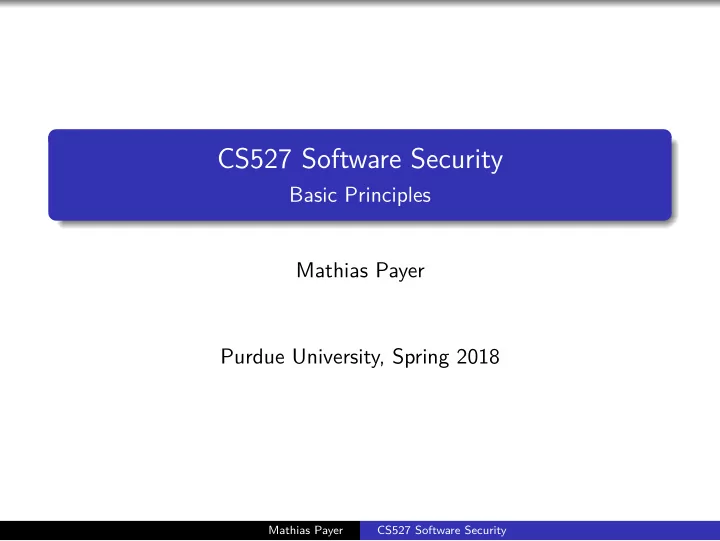

CS527 Software Security Basic Principles Mathias Payer Purdue University, Spring 2018 Mathias Payer CS527 Software Security
Software Security Allow inteded use of software, prevent unintended use that may cause harm. Mathias Payer CS527 Software Security
Security principles Confidentiality: an attacker cannot recover protected data Integrity: an attacker cannot modify protected data Availability: an attacker cannot stop/hinder computation Accountability/non-repudiation may be used as fourth fundamental concept. It prevents denial of message transmission or receipt. Mathias Payer CS527 Software Security
Security analysis Given a software system, is it secure? . . . it depends What is the attack surface? What are the assets? (How profitable is an attack?) What are the goals? (What drives an attacker?) Mathias Payer CS527 Software Security
Attacks and Defenses Attack (threat) models A class of attacks that you want to stop What is the attacker’s capability? What is impact of an attack? What attacks are out-of-scope? Defenses address a certain attack/threat model. General: e.g., stop memory corruptions Very specific: e.g., stop overwriting a return address Mathias Payer CS527 Software Security
Threat model A threat model defines an attacker’s abilities and resources. Awareness of entry points (and associated threats) Look at systems from an attacker’s perspective Decompose application: identify structure Determine and rank threats Determine counter measures and mitigation Reading material: https://www.owasp.org/index.php/ Application_Threat_Modeling Mathias Payer CS527 Software Security
Threat model: example Assume you want to protecy your valuables by locking them in a safe. In trust land, you don’t need to lock your safe. An attacker may pick your lock. An attacker may use a torch to open your safe. An attacker may use advanced technology (x-ray) to open the safe. An attacker may get access (or copy) your key. Mathias Payer CS527 Software Security
Cost of security There is no free lunch, security incurs overhead. Security is. . . expensive to develop, may have performance overhead, may be inconvenient to users. Mathias Payer CS527 Software Security
Fundamental security mechanisms Isolation Least privilege Fault compartments Trust and correctness Figure 1 Mathias Payer CS527 Software Security
Isolation Isolate two components from each other. One component cannot access data/code of the other component except through a well-defined API. Mathias Payer CS527 Software Security
Least privilege The principle of least privilege ensures that a component has the least privileges needed to function. Any privilege that is further removed from the component removes some functionality. Any additional privilege is not needed to run the component according to the specification. Note that this property constrains an attacker in the privileges that can be obtained. Mathias Payer CS527 Software Security
Fault compartments Separate individual components into smallest functional entity possible. General idea: contain faults to individual components. Allows abstraction and permission checks at boundaries. Note that this property builds on least privilege and isolation. Both properties are most effective in combination: many small components that are running and interacting with least privileges. Mathias Payer CS527 Software Security
Fault compartments Figure 2 Mathias Payer CS527 Software Security
Trust and correctness Specific components are assumed to be trusted or correct according to a specification. Formal verification ensures that a component correctly implements a given specification and can therefore be trusted. Note that this property is an ideal property that cannot generally be achieved. Mathias Payer CS527 Software Security
Hardware and software abstractions Operating System (OS) abstractions Hardware abstractions Mathias Payer CS527 Software Security
Operating System (OS) abstraction Provides process abstraction Well-defined API to access hardware resources Enforces mutual exclusion to resources Enforces access permissions for resources Restrictions based on user/group/ACL Restricts attacker Mathias Payer CS527 Software Security
Hardware abstraction Virtual memory through MMU/OS Only OS has access to raw physical memory DMA for trusted devices ISA enforces privilege abstraction (ring 0/3 on x86) Hardware abstractions are fundamental for performance Mathias Payer CS527 Software Security
Access control Authentication: Who are you (something you know, have, or are)? Authorization: Who has access to object? Audit/Provenance: I’ll check what you did. Mathias Payer CS527 Software Security
Types of access control Discretionary Access Control (DAC): Object owners specify policy Mandatory Access Control (MAC): Rule and lattice-based policy Role-Based Access Control (RBAC): Policy defined in terms of roles (sets of permissions), individuals are assigned roles, roles are authorized for tasks. Mathias Payer CS527 Software Security
DAC User has authority over resources she owns User determines permissions for her data if other users want to access it Mathias Payer CS527 Software Security
MAC Centrally controlled One entity controls what permissions are given Users cannot change policy themselves Mathias Payer CS527 Software Security
RBAC Access permission is broken into sets of roles. Users get assigned specific roles Administration privileges may be a role. Mathias Payer CS527 Software Security
Different security models Access control lists (static) Capabilities (static) Bell-LaPadula (state machine) Information flow (flow dependent) Mathias Payer CS527 Software Security
Access control matrix Provide access rights for subjects to objects. foo bar baz user rwx rw rw group rx r r other rx r Used, e.g., for Unix/Linux filesystems or Android/iOS/Java security model for privileged APIs. Introduced by Butler Lampson in 1971 http://research.microsoft.com/en-us/um/people/ blampson/08-Protection/Acrobat.pdf . Mathias Payer CS527 Software Security
Summary and conclusion Software security goal: allow intended use of software, prevent unintended use that may cause harm. Three principles: Confidentiality, Integrity, Availability. Security of a system depends on its threat model. Isolation, least privilege, fault compartments, and trust as concepts. Security relies on abstractions to reduce complexity. Reading assignment: Butler Lampson, Protection http://doi.acm.org/10.1145/775265.775268 Mathias Payer CS527 Software Security
Recommend
More recommend